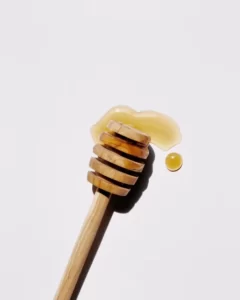Table of Contents
Wound healing is a significant public health concern worldwide, particularly in chronic wounds that experience delayed healing and are susceptible to bacterial infection. Nanomaterials have emerged as a promising approach in wound healing treatments due to their unique properties associated with their small size and large surface-area-to-volume ratio compared to bulk materials. These nanomaterials can be further enhanced by the addition of honey and propolis, which contain bioactive molecules such as polyphenols, flavonoids, peptides, and enzymes. These bionanomaterials can play a role in different stages of wound healing and through various mechanisms, including anti-inflammatory, antimicrobial, antioxidant, collagen synthesis stimulation, cell proliferation, and angiogenic effects. Using nanomaterials in wound therapy allows for targeted and continuous delivery of beekeeping products at the wound site, minimizing potential systemic adverse effects.
Introduction
Wound healing is a complex process that occurs in four stages: hemostasis, inflammation, proliferation, and remodeling. While acute wounds typically heal within a few weeks, chronic wounds can take years to heal and have a significant negative impact on patients’ well-being and healthcare costs. Chronic wounds are characterized by prolonged inflammation, increased neutrophil infiltration, oxidative stress, and a higher risk of infection. Researchers are actively exploring innovative therapeutic approaches to accelerate the healing process and control infections in chronic wounds.
Bionanomaterials in Wound Healing
Bionanomaterials are materials with at least one dimension in the nanometer scale and are synthesized using biological molecules. These materials offer several advantages in wound healing applications, including cost-effectiveness, efficient delivery systems, and prevention of bacterial infections. They are non-toxic, biocompatible, non-scarring, sterile, biodegradable, and possess excellent mechanical and physicochemical properties. Bionanomaterials can be loaded with bioactive molecules such as antibiotics, silver nanoparticles, natural extracts, growth factors, vitamins, and anti-inflammatory molecules to enhance the healing process. Nanofibers, for example, have a high surface-area-to-volume ratio, structural similarity to the skin extracellular matrix, porosity, and the ability to act as a drug delivery system, supporting cell adhesion, proliferation, and differentiation. These nanofibers can also serve as a barrier to prevent infections and promote effective skin regeneration.
Honey and Propolis in Wound Healing
Honey and propolis are beekeeping products that have gained attention as potential therapeutic agents in wound healing due to their anti-inflammatory, antibacterial, antioxidant, and wound healing properties. These natural products can be incorporated into various polymeric scaffolds, such as chitosan, cellulose, PVA, polycaprolactone, gelatin, and polyurethane. Honey and propolis contain bioactive molecules that promote wound healing, and their addition to polymeric scaffolds enhances their properties.
Honey, in particular, has been used for centuries in traditional medicine for wound healing. It has antibacterial properties, low cost, biocompatibility, and a high swelling index, making it suitable for clinical use. Honey-based nanoparticles have also shown promise in wound healing applications. However, there is a need for standardization methods to ensure consistent bioactivity in every use of honey.
Propolis is a resinous substance produced by bees that has antimicrobial, anti-inflammatory, and regenerative properties. It can be combined with polysaccharides such as cellulose, chitosan, starch, and alginate to create composites with potential applications in wound healing. The addition of propolis to these composites improves their efficacy as wound dressing materials. Electrospun mats produced from cellulose-based composites can provide sustained release of active propolis, further enhancing wound healing.
Recent Advances in Bionanomaterials for Wound Healing
In the past eight years, there has been a significant increase in research on bionanomaterials for wound healing. Researchers have focused on developing bionanomaterials based on various polymeric scaffolds combined with honey or propolis. These studies have explored the in vitro and in vivo effects of these bionanomaterials on wound healing.
To summarize the recent advances, we conducted a literature search in PubMed, Scopus, and Web of Science, as well as patent finders (WIPO and Espacenet), using the keywords “honey or propolis + scaffold + nanomaterial + wound healing.” The search yielded a wealth of information on the type of bionanomaterials, composition (honey, propolis, and polymeric scaffolds), biological and physicochemical/mechanical properties, potential applications, and patents related to wound healing.
Challenges and Future Directions
While significant progress has been made in the development of bionanomaterials for wound healing, there are still challenges and limitations that need to be addressed. One of the main challenges is the lack of standard operational methods and procedures for the production of bionanomaterials, particularly electrospun gelatin-based nanofibers. There is also a need to determine the optimal composition, concentration, and release period of bioactive components in these materials. Furthermore, the mechanisms by which these components promote wound healing are not fully understood.
Additionally, most studies on bionanomaterials for wound healing have been conducted on animal models, which have different regenerative capacities and mechanisms compared to humans. More research is needed to validate the efficacy and safety of these materials in clinical settings.
In conclusion, bionanomaterials based on polymeric scaffolds combined with honey or propolis show great potential for wound healing applications. These materials offer unique properties and advantages, including targeted and continuous delivery of bioactive molecules at the wound site. However, further research is needed to overcome the challenges and limitations associated with these materials and to facilitate their clinical translation. By addressing these issues, bionanomaterials could revolutionize wound healing treatments and improve patient outcomes.
References
-
Miguel SP, Ribeiro MP, Coutinho P, Correia IJ. Electrospun Polymers in Wound Healing: A Review. Biomacromolecules. 2018;19(3): 1887-1903.
-
Andreu V, Mendoza G, Arruebo M, Irusta S. Smart Dressings Based on Nanostructured Fibers Containing Natural Origin Antimicrobial, Anti-inflammatory, and Regenerative Compounds. Materials. 2015;8(9): 5154-5193.
-
Vilches-Moure JG, Jimenez-Vergara AC, Aguirre-Cruz L, et al. Antioxidant-Loaded Electrospun Fibers for Wound Healing Applications: A Comprehensive Review. Antioxidants. 2020;9(9): 843.
-
Nour S, Baheiraei N, Abbaspour M, Dehghan MM, Oryan A. Angiogenesis induction in tissue-engineered scaffolds designed for promoting skin regeneration. Journal of Biomedical Materials Research Part A. 2021;109(11): 2011-2039.
-
Adamu HA, Ismail A, Abdullahi R, Ahsan SM, Zuki ABZ, Yusof NA. Electrospinning of Bioactive Natural Polymers for Wound Dressing Application: A Comprehensive Review. International Journal of Molecular Sciences. 2021;22(5): 2573.
-
Bonsignore MR, Fava P, Barbagallo I. Honey as a Potential Natural Antimicrobial Compound against Multidrug-Resistant Bacteria. Molecules. 2021;26(6): 1520.
-
Tashkandi M. Honey as a Potential Natural Antimicrobial Agent against Pseudomonas aeruginosa. Antibiotics. 2021;10(5): 558.
-
Salama AH, El-Sakhawy M. Propolis-polysaccharides composites: Chemistry, synthesis and applications. Carbohydrate Polymers. 2021;252: 117214.
-
Stojko A, Kosikowska U, Kowalski S, et al. Biodegradable nonwovens with propolis as wound dressing materials: Evaluation studies. European Polymer Journal. 2021;153: 110525.
-
Hixon KR, Luong Q, Paranjape C, et al. Honey-Based Biomaterials for Wound Healing and Tissue Regeneration. Journal of Functional Biomaterials. 2019;10(1): 3.
-
Bahari M, Khalifehzadeh M, Saravanan M, et al. Electrospun gelatin-based nanofibers in biomedical applications. Journal of Drug Delivery Science and Technology. 2022;67: 102933.
-
Li Y, Sun B, Wu P. Electrospun Gelatin-Based Nanofibers for Wound Healing: A Review. Journal of Functional Biomaterials. 2022;13(2): 24.



